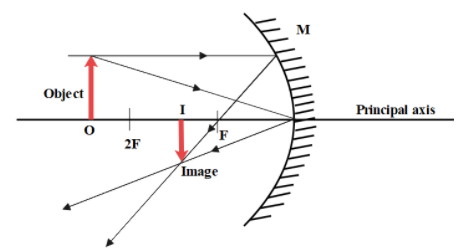
In a concave mirror, an object is placed at a distance $d_{1}$ from the focus and the image is formed at a distance $d_{2}$ from the focus. Then the focal length of the mirror is:
\[\begin{align}
& A.\sqrt{{{d}_{1}}{{d}_{2}}} \\
& B.{{d}_{1}}{{d}_{2}} \\
& C.\frac{{{d}_{1}}+{{d}_{2}}}{2} \\
& D.\sqrt{\frac{{{d}_{1}}}{{{d}_{2}}}} \\
\end{align}\]
Answer
564.6k+ views
Hint: The mirror formula is the relationship between the distance of an object $u$ , distance of image $v$ and the focal length of the lens $f$. This law can be used for both concave and convex mirrors with appropriate sign conventions. This sum is similar to an object placed in front of a spherical mirror. Hence using spherical mirror formula, we can find the image distance.
Formula:
$\dfrac{1}{u}+\dfrac{1}{v}=\dfrac{1}{f}$
Complete answer:
We know that a mirror reflects or bounces back, only a fraction of the beam of light in a single direction, as compared to other objects which either scatter light or absorb it. They are used to see one's reflection, like the normal mirror we use in house, or are used to see objects that are not visible directly, like rear mirrors and dentist’s mirror. There are various types of mirrors on the basis of shapes, like plane mirrors , the ones we use generally, which provide real images and curved mirrors, which may distort or magnify the image, generally seen in mirror mazes.
Let us assume that the focal length of the concave mirror is $f$. Let the object distance be $u$ and the image distance be $v$ from the mirror. Consider the image shown below, we have \[MO=u\], \[MI=v\] and \[MF=f\]. Given that, \[OF={{d}_{1}}\] and \[IF={{d}_{2}}\].
Then we have, $u=f+d_{1}$ and $v=f+d_{2}$

Then, substituting the values in the mirror formula, we get, $\dfrac{1}{f}=\dfrac{(f+d_{1})+(f+d_{2})}{(f+d_{1})(f+d_{2})}$
$\implies (f+d_{1})(f+d_{2})=f(f+d_{1}+f+d_{2})$
$\implies f^{2}+fd_{1}+fd_{2}+d_{1}d_{2}=2f^{2}+fd_{1}+fd_{2}$
$\implies 2 f^{2}-f^{2}=d_{1}d_{2}$
$\implies f=\sqrt{d_{1}d_{2}}$
Thus the correct answer is option (A) \[\sqrt{{{d}_{1}}{{d}_{2}}}\].
Note:
Mirror reflects or bounces back, only a fraction of the beam of light in a single direction. Be careful with the sign conventions used. Also note that the focal length is half the radius of curvature of the spherical mirror.
Formula:
$\dfrac{1}{u}+\dfrac{1}{v}=\dfrac{1}{f}$
Complete answer:
We know that a mirror reflects or bounces back, only a fraction of the beam of light in a single direction, as compared to other objects which either scatter light or absorb it. They are used to see one's reflection, like the normal mirror we use in house, or are used to see objects that are not visible directly, like rear mirrors and dentist’s mirror. There are various types of mirrors on the basis of shapes, like plane mirrors , the ones we use generally, which provide real images and curved mirrors, which may distort or magnify the image, generally seen in mirror mazes.
Let us assume that the focal length of the concave mirror is $f$. Let the object distance be $u$ and the image distance be $v$ from the mirror. Consider the image shown below, we have \[MO=u\], \[MI=v\] and \[MF=f\]. Given that, \[OF={{d}_{1}}\] and \[IF={{d}_{2}}\].
Then we have, $u=f+d_{1}$ and $v=f+d_{2}$

Then, substituting the values in the mirror formula, we get, $\dfrac{1}{f}=\dfrac{(f+d_{1})+(f+d_{2})}{(f+d_{1})(f+d_{2})}$
$\implies (f+d_{1})(f+d_{2})=f(f+d_{1}+f+d_{2})$
$\implies f^{2}+fd_{1}+fd_{2}+d_{1}d_{2}=2f^{2}+fd_{1}+fd_{2}$
$\implies 2 f^{2}-f^{2}=d_{1}d_{2}$
$\implies f=\sqrt{d_{1}d_{2}}$
Thus the correct answer is option (A) \[\sqrt{{{d}_{1}}{{d}_{2}}}\].
Note:
Mirror reflects or bounces back, only a fraction of the beam of light in a single direction. Be careful with the sign conventions used. Also note that the focal length is half the radius of curvature of the spherical mirror.
Recently Updated Pages
Master Class 12 Business Studies: Engaging Questions & Answers for Success

Master Class 12 Social Science: Engaging Questions & Answers for Success

Master Class 12 English: Engaging Questions & Answers for Success

Master Class 12 Chemistry: Engaging Questions & Answers for Success

Class 12 Question and Answer - Your Ultimate Solutions Guide

Master Class 12 Economics: Engaging Questions & Answers for Success

Trending doubts
What are the major means of transport Explain each class 12 social science CBSE

Which are the Top 10 Largest Countries of the World?

Draw a labelled sketch of the human eye class 12 physics CBSE

How much time does it take to bleed after eating p class 12 biology CBSE

Explain sex determination in humans with line diag class 12 biology CBSE

Differentiate between homogeneous and heterogeneous class 12 chemistry CBSE




